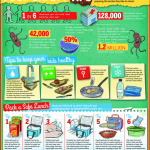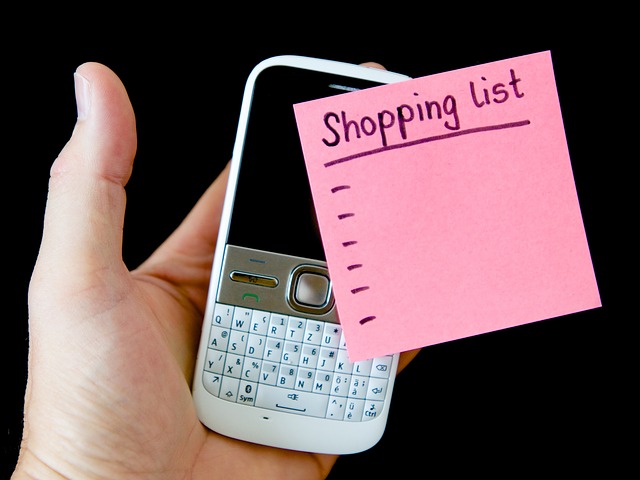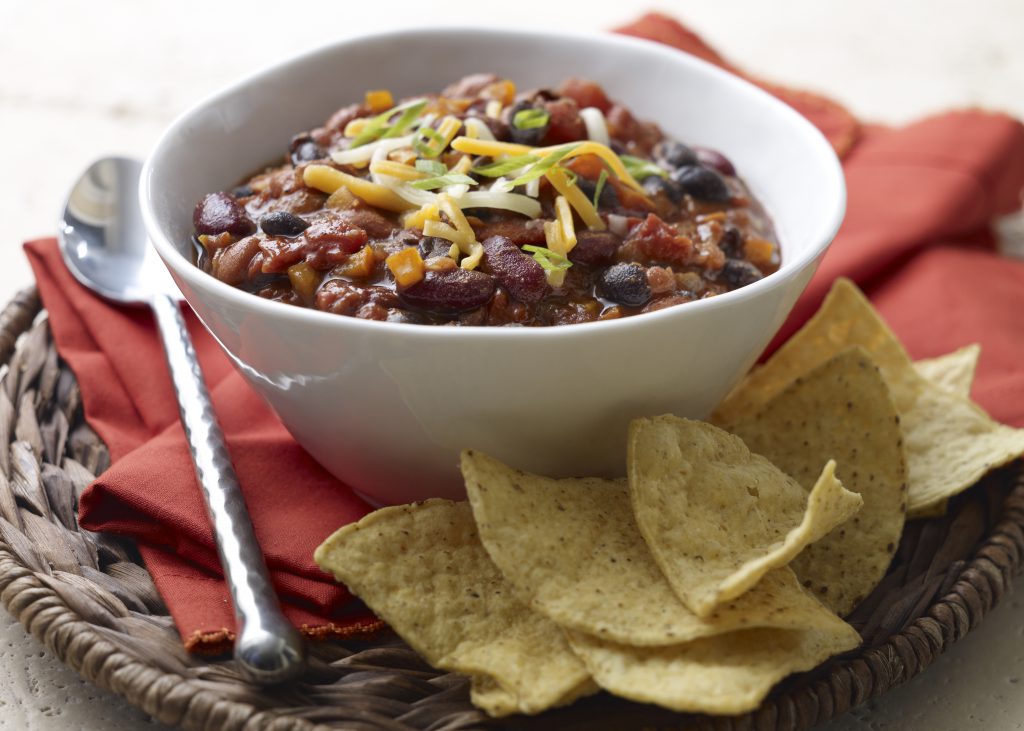Celebrate the Earth and Stretch Your Food Dollar!

Today is Earth Day and what better way to celebrate than by saving some green by going green with your grocery shopping. These tips adapted from Alice Henneman, Extension Educator at the University of Nebraska will take you beyond recycling the various packages that your food comes in and will help you save money, adding a little extra green in your pocket!
- Size matters. – Buy the biggest container that you can afford. Do you really need to purchase individual containers if you eat them all at home?
- It’s in the bag. – Carry reusable shopping bags when possible. If you don’t, reuse plastic grocery bags to line small wastebaskets and make trash disposal easier.
- Gotta have a plan! Reduce fuel consumption by planning ahead and shopping less often.
- Practice the 3 Rs. Reduce, Reuse and Recycle
- Reduce the amount of food thrown away by serving smaller portions of food. You can always go back for more if needed.
- Reuse leftovers by planning to serve them again within two days or freezing for future use. Be sure to label and date your container.
- Recycle leftovers into a different meal; for example – leftover roasted chicken can be turned into chicken salad, soup, casseroles or tacos.
- Don’t be a “spoil”-sport. Throwing away spoiled food is just like throwing away leftovers. Follow these practices to reduce the amount of spoiled food you toss:
- Read labels for “use by,” “expiration,” or “best if used by” dates.
- Refrigerate and freeze your food at the proper temperatures—0 degrees F or lower for freezers and 40 degrees F or lower for the refrigerator. Use an appliance thermometer for accuracy.
- Follow recommended storage times for foods to maintain quality and safety of food products.
- Avoid buying too much food in bulk especially if it can spoil before you use it.
- Drink to this. Buy a reusable water bottle and fill it with tap water. Think of the savings to your wallet and the reduction of water bottles in the landfill.
- Bulk it up. Many household products such as hand soap can be purchased in larger bottles and used to refill a smaller bottle. This will reduce cost and also save landfill space.
If all these ideas seem overwhelming, choose one or two to work on for this month. Then add another one or two next month. Keep adding new practices until you are doing all of them. Soon you will see those extra dollars adding up. Take that extra money and start a fund for something special for yourself or the kids. You’ll be surprised at how fast it adds up!
Suzanne
Meals on the Go: Pack Them Safely

The bagged lunch looks much different today than it once did. Most of us felt limited to carrying the traditional sandwich, chips and drink because of safety reasons. Although this is a good option, when repeatedly eaten, it gets pretty boring! There are many different lunch options including leftovers of a favorite main dish that be safely enjoyed a day or two later as a packed lunch for school or work.
Whether it is a student taking lunch to school or an adult packing lunch for work, millions will take “bag” lunches with them each day and will want to make sure their food is safe to eat.Here are a couple of tips on how you can safely pack you and your child’s lunch.
- Keep Foods Clean: Keep everything clean when packing the lunch. That not only goes for the food, but also food preparation surfaces, hands and utensils. Use hot, soapy water. Keep family pets away from kitchen counters. Wash your hands before you prepare or eat food.
- Keep Foods Out of Danger Zone: Bacteria grow and multiply rapidly in the danger zone between 40 ºF and 140ºF for more than 2 hours (1 hour when the temperature is above 90 F). At room temperature, just ONE bacterium could grow to 2,097,152 bacteria in 7 hours. Keep lunches out of direct sunlight and away from radiators or other heat sources. Some foods that don’t require refrigeration and are great to include in a bag lunch are fruits, vegetables, hard cheese, unopened canned meat or fish, chips, bread, crackers, peanut butter, jelly, mustard and pickles.
- Keep Cold Foods Cold: The best way to keep food cold is with an insulated box. When packing lunches, include either freezer gel packs or cold food items such as small frozen juice packs. Nestle perishable meat, poultry or egg sandwiches between these cold items. Sandwiches can also be made ahead of time and kept refrigerated or frozen before placing in the lunch box. Freezer gel packs will hold cold food until lunchtime, but generally will not work for all-day storage. Any perishable leftovers after lunch should be discarded and not brought home. Of course, if there’s a refrigerator at work, store perishable items there upon arrival. Leftover perishables that have been kept refrigerated should be safe to take home. Brown paper bags or plastic lunch bags can also be used to store foods if you are not carrying perishable foods, but they do not work as well for cold foods. The bag tends to become soggy or leak as cold foods thaw, and the bags do not retain the cold as well as an insulated lunch box. If a freezer gel pack is being used in the paper bag, it will cause additional moisture as it melts. Wrap the freezer pack in plastic or foil and use an extra paper bag to create a double layer to help solve the problem.
- Keep Hot Foods Hot: Foods like soup, chili and stew need to stay hot. Use an insulated bottle stored in an insulated lunch box. Fill the bottle with boiling water, let stand for a few minutes, empty and then put in the piping hot food. Keep the insulated bottle closed until lunch to keep the foods hot. Byfollowing these safety tips, you can avoid foodborne illnesses when eating from a lunch box or bag lunch.
Sources: http://www.clemson.edu/extension/hgic/food/pdf/hgic3600.pdf and http://food.unl.edu/packed-lunch-safety
Stephanie
Tips for Managing Stress as a Family

Webster’s Dictionary defines stress as “a state of mental tension and worry caused by problems in your life, work, etc.” According to the Center for Disease Control and Prevention, some stress can be positive (in that it helps one develop the skills needed to cope with different situations in life) and some stress can be negative. Negative stress causes anxiety that can affect the way we think and behave. Negative stress can even affect our health. And, although we think adults more affected than adolescents or children, anyone can experience stress. As parents, we should be aware of the situations that can cause our children stress and carefully watch for how stress presents itself in our children.
Stress can be caused by a natural disaster (like an earthquake, hurricane, tornado, or wildfire). It can also be the result of bullying, poor grades, or what our children hear on the news (school shootings or other community/world violence such a terror attacks). Symptoms of stress can commonly include:
- Feeling sad or frustrated
- Feeling fearful, irritable, angry or guilty
- Difficulty concentrating and making decisions
- Crying
- Reduced interest in usual activities
- Wanting to be alone
- Loss of appetite
- Sleeping too much or too little
- Nightmares or bad memories
- Reoccurring thoughts about an event
- Headaches or stomach problems
- Increased heart rate, difficulty breathing
As a parent, it’s our responsibility to help our children cope with stress. Talking with our children about a stressful situation can help alleviate their negative feelings. Monitoring their exposure to an event (what they watch and hear on television reports or in adult conversations) can help bring a rational balance to the situation. Other suggestions for helping your child cope with stress can be:
- Maintain a normal routine – Ensure they wake up, go to bed, eat, etc. at the regular time. This brings a sense of stability.
- Encourage expression – Take the time to talk with and listen to your child. This will let your child know his that his fears and worries are understandable, and his thoughts and feelings are important to you.
- Watch and listen – Any change in behavior can be a sign that your child is having trouble coping or coming to terms with an event or situation.
- Reassure – Let your child know how your family, the school, the community is taking steps to ensure his safety.
- Connect with others – Make an effort to talk with other parents, teachers, school counselors, health professionals, and anyone else who can help give support in the effort to ensure your child’s well-being.
Recognizing the symptoms and being able to help your child cope with the stress in his life can turn a negative situation into a positive developmental experience. Read more about stress and how to help your child cope with it on one of these sites:
- https://www.ces.ncsu.edu/depts/fcs/pdfs/fcs457.pdf
- http://kidshealth.org/en/parents/stress-coping.html
- https://www.healthychildren.org/English/healthy-living/emotional-wellness/Pages/Helping-Children-Handle-Stress.aspx
Virginia
Go Meatless for Good Health
Going meatless at least once a week can help improve your health. Red and processed meats, which is high in saturated fat, may increase your risk of developing chronic diseases. Try replacing meat with high fiber alternatives such as beans and lentils (among other foods). Visit eatright.org for more information. Going meatless one day a week gives you a chance to explore new recipes. To help get you started, check out this vegetable chili recipe that is healthy and tasty.
Vegetable Chili Boat
Serves 6
Ingredients
2 1/2 teaspoons canola oil
1/2 cup Fresh onion, peeled, diced
1/2 cup Fresh green bell pepper, seeded, diced
1/2 cup Canned low-sodium pinto beans, drained, rinsed
1/2 cup Canned low-sodium kidney beans, drained, rinsed
1 cup Canned low-sodium black beans, drained, rinsed
1 1/2 tablespoons chili powder
1 1/3 cups Canned low-sodium diced tomatoes
1 cup Low-sodium chicken stock
1 dash hot sauce (optional)
1/4 cup Canned low-sodium tomato paste
18 Low-sodium tortilla chips (about 3 oz)
1/4 cup reduced-fat cheddar cheese, shredded (1 oz)
1/4 cup Low-fat mozzarella cheese, low moisture, part skim, shredded (1 oz)
Directions
1. Heat canola oil in a large pot over medium-high heat. Add onions and green peppers. Cook for 2-3 minutes or until tender. Add beans and stir to coat. Add chili powder. Stir. Cook for 1 minute for flavors to blend.
2. Add tomatoes, chicken stock, and hot sauce. Bring to a boil. Simmer uncovered for 10 minutes. Add tomato paste and mix well. Cook uncovered for an additional 10 minutes. Bring to a rolling boil for at least 15 seconds. Reduce heat to low and simmer to keep warm.
3. Combine cheddar and mozzarella cheeses (the cheese is a garnish).
4. Place ¾ cup chili in a bowl. Top with 3 chips and sprinkle with about 1 tablespoon of cheese blend. Serve hot.
¾ cup provides:
Legume as Meat Alternate: 1 oz equivalent meat alternate, ¼ cup red/orange vegetable, and ¼ cup oz equivalent grains.
OR
Legume as Vegetable: ¼ oz meat alternate, 1/8 cup legume vegetable, ¼ cup red/orange vegetable, 1/8 cup other vegetable, and ¼ oz equivalent grains.
Legume vegetable can be counted as either a meat alternate or as a legume vegetable but not as both simultaneously.
Source: https://recipesforkids.devpost.com/submissions/831-vegetable-chili-boat
Frugal Family Shopping
If not planned properly, grocery shopping can be a challenging task, consuming a lot of time and money. It’s important to be well prepared to get the most for your money while eating healthy.

When shopping, try to make a list of everything that is needed for the week, including breakfasts, lunches, dinners, and snacks. This method makes it easier to stick to a budget and resist the temptation to purchase unnecessary food products. I have realized that I am more motivated to cook rather than picking something up from a restaurant because everything that is needed is within reach. Also, shopping sales at various stores in the area ensures that I am getting a good deal on my favorite products. The local farmer’s market is a great resource to purchase homegrown produce that is in season, while supporting the community.
The unit price can be very helpful when choosing products, which illustrates the price per pound, ounce, or pint. A bulk item may cost more than the convenient sizes, but you are getting more for the money. I buy in bulk whenever possible and package it myself, which helps to save in the long run.
-Danielle
